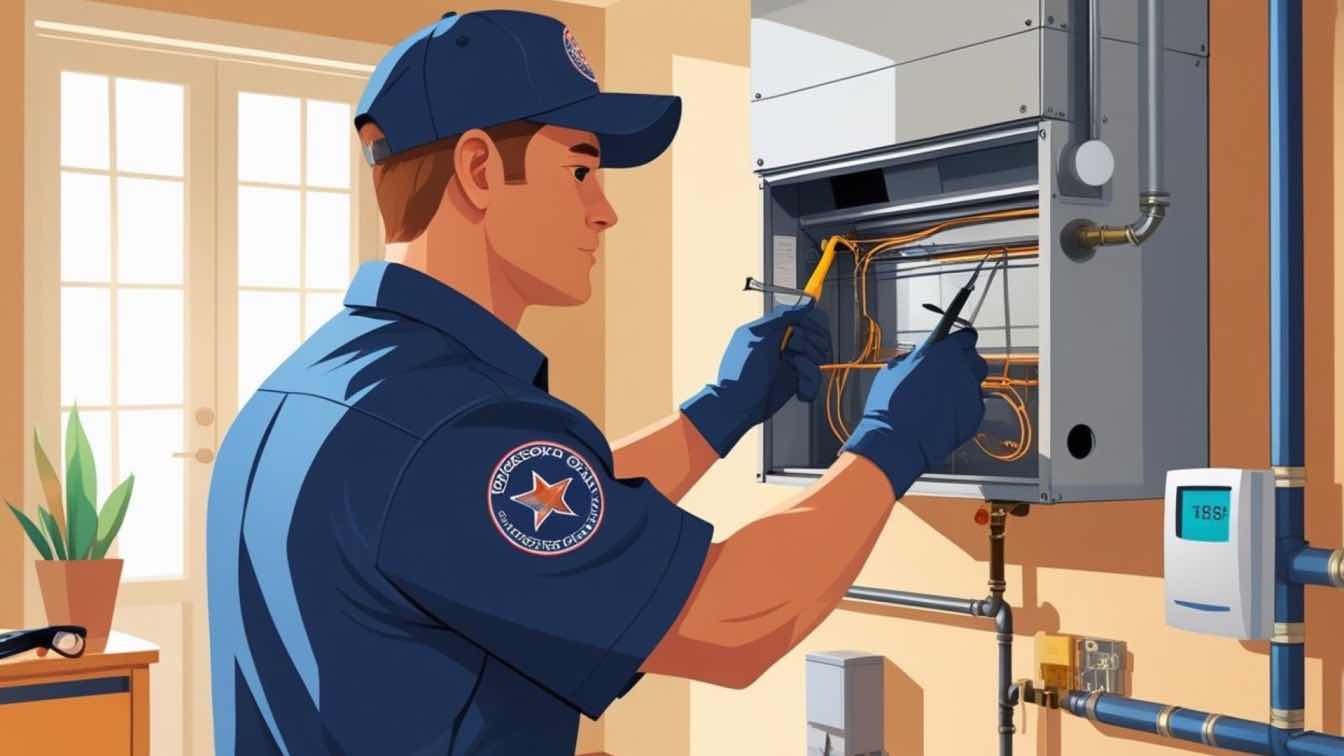Houston homeowners face unique heating challenges due to the city's unpredictable weather patterns and extreme temperature fluctuations. The combination of high humidity, sudden cold snaps, and occasional severe weather can place significant stress on heating systems throughout the year.
Proper heater maintenance and timely repairs can prevent costly emergency breakdowns and extend your system's lifespan by several years. Many heating issues develop gradually and become more expensive to fix when left unaddressed, making early detection and professional intervention crucial for Houston residents.
Understanding when to perform basic maintenance, recognize warning signs, and call professional technicians helps homeowners make informed decisions about their heating systems. This guide provides practical strategies for maintaining optimal heater performance and determining whether repair or replacement offers the best long-term value for your specific situation. For reliable service, homeowners often turn to trusted heater repair Houston specialists who can quickly diagnose problems and restore comfort before small issues escalate.
Essential Heater Repair Tips for Houston Residents
Houston homeowners face unique heating challenges due to the region's humid climate and temperature fluctuations. Understanding how to identify problems early and knowing when professional intervention is necessary can prevent costly breakdowns during winter months.
Identifying Common Heater Problems
Inadequate heating represents the most frequent issue Houston residents encounter. Systems may struggle to reach desired temperatures or take excessive time to warm spaces effectively.
Strange noises often indicate mechanical problems. Rattling sounds typically suggest loose components, while grinding noises may signal worn bearings or motor issues.
Frequent cycling occurs when heaters turn on and off repeatedly without maintaining consistent temperatures. This problem wastes energy and strains system components.
Poor air quality manifests through dust accumulation, musty odors, or increased allergens circulating throughout the home. These symptoms often point to filter problems or ductwork issues.
Uneven heating creates temperature variations between rooms. Cold spots usually indicate blocked vents, ductwork leaks, or inadequate system capacity for the home's size.
High energy bills without increased usage suggest declining efficiency. Aging components or maintenance neglect commonly cause this gradual performance deterioration.
Signs Your Heater Needs Immediate Repair
Complete heating failure requires urgent professional attention, especially during Houston's occasional cold snaps when temperatures drop significantly.
Gas odors near heating equipment demand immediate action. Homeowners should shut off gas supplies and contact emergency services before calling repair technicians.
Electrical issues including frequent breaker trips, sparking, or burning smells pose serious safety risks. These problems require immediate system shutdown and professional evaluation.
Carbon monoxide indicators such as headaches, dizziness, or detector alarms signal dangerous conditions. Residents must evacuate immediately and seek emergency assistance.
Water leaks around heating equipment can damage property and indicate serious internal component failures requiring prompt professional intervention.
Yellow flame color in gas heaters instead of blue flames suggests incomplete combustion and potential carbon monoxide production.
Expert Recommendations for Effective Repairs
Annual professional inspections help identify problems before they become major failures. Houston's climate demands regular maintenance due to higher system usage patterns.
Filter replacement every 30-90 days prevents airflow restrictions and maintains indoor air quality. Houston's humid conditions require more frequent attention to prevent mold growth.
Thermostat calibration ensures accurate temperature control and prevents unnecessary system cycling. Professional technicians can verify proper operation and recommend upgrades when needed.
Ductwork inspection addresses leaks and blockages that reduce efficiency. Houston homes often experience duct problems due to foundation settling and moisture exposure.
System age consideration helps determine repair versus replacement decisions. Units over 10-15 years old may benefit more from replacement than extensive repairs.
Professional diagnosis provides accurate problem identification and cost-effective solutions. Experienced technicians understand Houston's specific climate challenges and equipment requirements.
Diagnosing and Preventing Heater Issues
Early detection of heating problems saves homeowners significant repair costs and prevents system breakdowns during peak usage periods. Common issues include thermostat malfunctions, temperature inconsistencies throughout the home, and unexpected increases in monthly energy consumption.
Troubleshooting Thermostat Challenges
A malfunctioning thermostat causes the majority of heating complaints in Houston homes. The device may display incorrect temperatures, fail to communicate with the heating system, or have dead batteries.
Homeowners should first check if the thermostat display is functioning properly. A blank or dim screen often indicates battery replacement is needed. Digital thermostats typically require AA or AAA batteries changed annually.
Temperature calibration issues manifest when the displayed temperature differs from actual room temperature by more than two degrees. A simple comparison with a separate thermometer reveals calibration problems.
Programmable thermostat settings may override manual adjustments. Users should verify the programmed schedule matches their daily routines. Incorrect programming leads to unexpected temperature changes throughout the day.
Dust accumulation inside the thermostat affects sensor accuracy. Gentle cleaning with compressed air removes debris from internal components. Professional technicians should handle complex wiring issues or complete thermostat replacement.
Addressing Uneven Heating in Your Home
Uneven heating creates uncomfortable temperature variations between rooms and floors. This issue typically stems from blocked vents, ductwork problems, or inadequate system capacity.
Furniture placement often blocks air vents and restricts airflow. Homeowners should maintain at least 12 inches of clearance around supply and return vents. Heavy curtains or rugs covering floor vents also impede proper air circulation.
Ductwork inspection reveals common problems affecting heat distribution:
1. Disconnected or damaged ducts
2. Excessive dust buildup in air passages
3. Poorly sealed joints allowing heated air to escape
4. Undersized ducts for room requirements
Closed or partially closed dampers in the ductwork system create temperature imbalances. These adjustable plates control airflow to different zones and may have shifted over time.
Heating system capacity affects the ability to warm larger spaces effectively. Systems undersized for square footage struggle to maintain consistent temperatures during peak demand periods.
Understanding Energy Bill Spikes
Sudden increases in energy bills often indicate declining heating system efficiency or developing mechanical problems. Monthly consumption patterns help identify when issues began affecting system performance.
Common causes of increased energy consumption include:
|
Issue |
Impact on Bills |
Warning Signs |
|
Dirty air filters |
15-20% increase |
Reduced airflow, frequent cycling |
|
Aging equipment |
20-30% increase |
Longer run times, poor heating |
|
Ductwork leaks |
25-40% increase |
Uneven temperatures, dust buildup |
Air filters clogged with dust and debris force heating systems to work harder. Standard filters require monthly replacement during peak usage seasons. High-efficiency filters may last up to three months depending on household conditions.
System age directly correlates with energy efficiency. Heating systems over 15 years old typically consume 30% more energy than newer models. Regular maintenance helps older systems operate more efficiently.
Programmable thermostat programming errors lead to unnecessary energy consumption. Incorrect schedules may heat empty homes during work hours or maintain higher temperatures than needed overnight.
Heater Maintenance Strategies for Long-Term Performance
Regular heater maintenance reduces energy bills by up to 15% while extending system lifespan by several years. Property owners who implement consistent maintenance schedules prevent 80% of emergency repairs through early detection of wear patterns.
Routine Maintenance Checklist
Monthly filter inspections form the foundation of effective heater maintenance. Dirty filters restrict airflow and force heating systems to work harder, increasing energy consumption by 5-15%.
Replace standard filters every 1-3 months depending on usage and home conditions. Homes with pets or high dust levels require monthly replacements.
Essential Monthly Tasks:
- Check and replace air filters
- Inspect vents for obstructions
- Test thermostat accuracy with separate thermometer
- Listen for unusual noises during operation
Seasonal Tasks:
- Clean supply and return vents
- Check outdoor unit clearance (2-3 feet minimum)
- Inspect ductwork for visible damage
- Test safety switches and controls
Annual professional inspections catch problems that homeowners typically miss. Technicians examine heat exchangers, electrical connections, and gas line integrity during these comprehensive evaluations.
Optimizing System Efficiency Year-Round
Programmable thermostats reduce energy bills by automatically adjusting temperatures when spaces are unoccupied. Setting temperatures 7-10 degrees lower during 8-hour periods can cut heating costs by 10%.
Proper insulation works alongside heating system maintenance to maximize efficiency. Sealing air leaks around windows, doors, and ductwork prevents heated air from escaping.
Temperature Settings for Maximum Efficiency:
- Occupied periods: 68-70°F
- Sleep hours: 60-65°F
- Away periods: 55-60°F
Ductwork maintenance significantly impacts system performance. Leaky ducts waste 20-30% of heated air before it reaches living spaces, forcing the heating system to run longer cycles.
Professional duct sealing typically pays for itself within 2-3 years through reduced energy bills. Clean ducts also improve indoor air quality by preventing dust circulation.
Professional vs. DIY Care
Property owners can safely handle basic maintenance tasks like filter changes and vent cleaning. However, gas line inspections, electrical work, and internal component servicing require professional expertise.
Safe DIY Tasks:
- Filter replacement
- Vent cleaning
- Thermostat battery changes
- Outdoor unit debris removal
Professional-Only Services:
- Gas line inspections
- Heat exchanger cleaning
- Electrical connection testing
- Combustion analysis
Annual professional maintenance contracts typically cost $100-200 but prevent repairs averaging $300-500. Trained technicians use specialized tools to measure system efficiency and detect carbon monoxide leaks.
Emergency repairs during peak heating season cost 25-40% more than scheduled maintenance visits. Professional maintenance also preserves manufacturer warranties that often require documented annual service.
When to Repair or Replace Your Heating System
Homeowners face critical decisions when their heating systems malfunction, with repair costs, system age, and efficiency playing key roles in determining the most cost-effective solution. Professional evaluation helps identify whether minor adjustments can restore performance or if complete replacement offers better long-term value.
Evaluating the Lifespan of Your Heater
Most heating systems reach peak efficiency during their first 10-15 years of operation. Systems approaching or exceeding this age range typically require more frequent heater repairs and consume more energy to maintain desired temperatures.
Age-Based Performance Indicators:
- Systems under 10 years: Usually respond well to standard heater repair services
- Systems 10-15 years: Require careful cost analysis before major repairs
- Systems over 15 years: Often benefit from replacement consideration
Older heating systems lose efficiency gradually, making temperature regulation increasingly difficult. A heater that struggles to reach desired temperatures within reasonable timeframes may indicate significant internal wear.
Performance degradation often accelerates after the 15-year mark. Components like heat exchangers, blower motors, and control systems experience normal wear that becomes costly to address through individual heater repairs.
Factors That Influence Repair Decisions
Several technical factors determine whether heater repair represents the optimal choice for system restoration. Frequency of recent repairs provides insight into overall system reliability and future maintenance requirements.
Critical Decision Factors:
- Number of service calls within the past two years
- Type and severity of current malfunction
- Availability of replacement parts for older models
- Energy efficiency ratings compared to current standards
Systems requiring multiple heating system repairs within short timeframes often indicate cascading component failures. Major component failures like cracked heat exchangers or failed compressors typically warrant replacement consideration rather than extensive repairs.
Energy efficiency becomes increasingly important as utility costs rise. Newer systems achieve significantly higher efficiency ratings than units manufactured even five years ago, potentially offsetting replacement costs through reduced monthly bills.
Cost Considerations and Expert Guidance
Financial analysis forms the foundation of repair versus replacement decisions for any heating system. Professional technicians recommend replacement when repair costs exceed 50% of new system installation expenses.
Cost Analysis Framework:
1. Current repair estimate vs. replacement cost
2. Projected annual energy savings with new system
3. Warranty coverage differences between options
4. Long-term maintenance requirements
Emergency repairs during peak season often carry premium pricing that affects cost calculations. Planning heating system maintenance during off-peak periods allows for more thorough evaluation and better pricing options.
Professional HVAC technicians provide unbiased assessments of system condition and repair feasibility. They identify root causes of problems rather than addressing symptoms, helping homeowners make informed decisions about their heating systems.
Qualified contractors evaluate multiple repair scenarios and present clear cost comparisons. They consider factors like refrigerant type compatibility, code compliance requirements, and manufacturer warranty implications when recommending heater repair versus replacement options.





